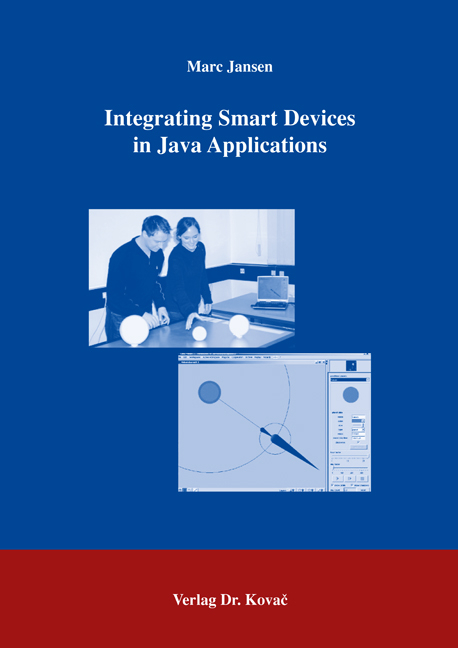
Integrating Smart Devices in Java Applications
Seiten
2006
|
1., Aufl.
Kovac, Dr. Verlag
978-3-8300-2374-6 (ISBN)
Kovac, Dr. Verlag
978-3-8300-2374-6 (ISBN)
- Keine Verlagsinformationen verfügbar
- Artikel merken
This book deals with the question of how to integrate Smart Devices in Java applications. Therefore, it provides a motivation why Smart Devices should be integrated in Java applications. This motivation basically looks at the CSCL/CSCW domain and uses the latest research in this domain to motivate the necessity of a framework that supports developers by the integration of Smart Devices in Java applications. Furthermore, a short overview about existing technologies is provided. Namely Jini, J2ME,.Net Compact Framework and JXTA are supposed to be frameworks that already help by the integration of Smart Devices. This work does not only present a rough overview about the mentioned frameworks but it also discusses the advantages and drawbacks of each of them. One result of this discussion is that there is still a need for a dedicated framework that supports developers by the integration of Smart Devices in Java applications.
Additionally, a theoretical approach that allows for modeling the relationship between different Smart Devices is presented. Within this approach certain communication patterns that usually occur while working with Smart Devices are explained. These communication patterns are used to describe a routing algorithm that allows for routing in a network of Smart Devices.
After the presentation of this theoretical approach, a practical implementation of the approach is presented in detail. This practical implementation allows for a great deal of integration just by describing the necessary devices in a certain XML dialect that is also developed in the theoretical part of this work.
As to encourage developers to use the developed framework, certain examples of how the framework can be used in different scenarios are presented. Last but not least, this work finishes with a number of examples in which the presented framework and therefore also the theoretical approach was already used.
Additionally, a theoretical approach that allows for modeling the relationship between different Smart Devices is presented. Within this approach certain communication patterns that usually occur while working with Smart Devices are explained. These communication patterns are used to describe a routing algorithm that allows for routing in a network of Smart Devices.
After the presentation of this theoretical approach, a practical implementation of the approach is presented in detail. This practical implementation allows for a great deal of integration just by describing the necessary devices in a certain XML dialect that is also developed in the theoretical part of this work.
As to encourage developers to use the developed framework, certain examples of how the framework can be used in different scenarios are presented. Last but not least, this work finishes with a number of examples in which the presented framework and therefore also the theoretical approach was already used.
| Reihe/Serie | Schriftenreihe Forschungsergebnisse zur Informatik ; 62 |
|---|---|
| Sprache | englisch |
| Maße | 150 x 210 mm |
| Gewicht | 333 g |
| Einbandart | gebunden |
| Themenwelt | Informatik ► Programmiersprachen / -werkzeuge ► Java |
| Schlagworte | 2005 • CSCL • CSCW • Hardcover, Softcover / Informatik, EDV/Programmiersprachen • HC/Informatik, EDV/Programmiersprachen • Integration • Java • Modelling • Smart Devices • Universität Duisburg-Essen |
| ISBN-10 | 3-8300-2374-X / 383002374X |
| ISBN-13 | 978-3-8300-2374-6 / 9783830023746 |
| Zustand | Neuware |
| Haben Sie eine Frage zum Produkt? |
Mehr entdecken
aus dem Bereich
aus dem Bereich
mit über 150 Workouts in Java und Python
Buch (2023)
Carl Hanser (Verlag)
29,99 €
Einführung, Ausbildung, Praxis
Buch | Hardcover (2023)
Rheinwerk (Verlag)
49,90 €


